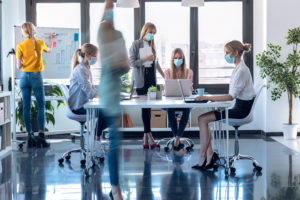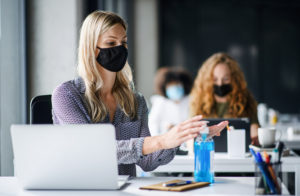Ensuring a Healthy and Comfortable Working Environment
As office spaces reopen and prepare for the “new normal”, building owners and EHS (Environment, Health and Safety) managers are forced to adapt and develop new protocols to reduce risk of infection in the workplace. Beyond masks and tons of hand sanitizer, what can be done to reduce mass quarantines inside your building?
The virus’s delayed symptoms and highly contagious nature make it tricky to protect your staff, visitors and tenants from. Some of the latest COVID-19 safety measures put in place by EHS teams across the world include1:
- Increasing scheduled cleanings- and adding additional sanitation practices in predefined hotspots (bathrooms, coffee, water stations, etc.)
- Installing plexiglass barriers between desks where distance is not possible
- Daily symptom checks of all people entering the building
- Instilling new regulations for social distancing within communal spaces (like eating and meeting areas)
- Grouping / creating shifts for workers to minimize interactions
- Managing interactions and max capacity to ensure social distancing
While tedious, most of these practices are straightforward enough. The bigger hurdle is ensuring compliance with new regulations, in order to provide the safest working environment possible.
Hardware-free and quickly implemented indoor positioning from Oriient provides a unique tech solution to simplify management of these safety procedures – and most importantly, it’s easily integrated into existing building apps.
Full Visibility: Compliance within your building
Using Indoor GPS, you can automatically begin location tracking upon a person’s entrance to your building. To avoid privacy concerns, data is kept anonymous unless there is a known case of infection – in which case contact tracing can be enabled to notify those who have been in close proximity to an infected person (find out more about how Oriient hacks indoor contact tracing here).
Why is that kind of accuracy necessary? In case of infection, you can get a clear account of an infected person’s interactions within your building, allowing you to pinpoint which people should stay home, and safely avoid a mass closure or quarantine.
By requesting that people keep their phones on them within your building, you can get a full analytical understanding of the number of people within any given area – at room level. This allows you to monitor and regulate capacity of any given area, as well as the building as whole.
With full data on foot traffic and capacity inside your building, EHS teams can strategize to alleviate congestion, enforce regulations and manage interactions – ultimately creating a fully compliant and low-risk work environment.
Social Distancing
Information about how COVID-19 is spread is constantly growing and changing – and regulations change with it. Keeping track and notifying people about the updates to protocol can be a challenge, but Indoor GPS can help manage this.
Using a real-time monitor and retrospective tracking analysis of people within your space, you can keep tabs on room occupancy as well as distance between employees and visitors, to ensure all distancing regulations are being met. Send a notification to those who have violated the required space between one another or maximum capacity of a room – greatly helping EHS team members to confirm on-site compliance.
Cleaning and Sanitation
Providing cleaning staff with an app helps them adhere to the new regulations – while you keep track of compliance via a real-time monitor showing their live locations, or retrospectively confirm they visited the areas they’ve been assigned to.
Using indoor positioning, you can send reminders to staff about the new cleaning schedule while directing them to the “hotspot” areas that require more frequent sanitation via real-time navigation routes. In the case of an infected person, you can send cleaning teams along their route within your building to complete extra sanitation in every space they visited.
Indoor positioning enables building users to direct attention to areas that require cleaning via their smartphone, while sending an alert of the exact location to your cleaning team.
User Experience
“…companies that are reimagining their spaces also must invest in technology to keep track of these moving parts. This intelligence will better help organizations understand what portion of their portfolios is best suited for long-term committed space is flexible, just-in-time space—all the while providing a sense of place for their employees. “
— Global Outlook 2030 by CBRE
Even before COVID-19 and months of quarantine and remote working, it was predicted that flexible working spaces will replace traditional offices in the near future.
Flexible workspaces present their own challenges – with employees changing working locations on a daily basis, you can expect a fair amount of time to be wasted as they search for where they need to be. Indoor positioning enables real-time navigation via a smartphone – to a new workspace, meeting room or colleague, eliminating aimless wandering, saving time and improving user experience (and productivity!).
“To meet those demands and to encourage that degree of face-to-face interaction, employers must create spaces that cultivate the creative output of high-skilled workers and make them feel valued and productive while they’re there.”
— Global Outlook 2030 by CBRE
As working from home becomes ubiquitous, Oriient’s hardware-free solution for indoor positioning provides the necessary tools to analyze and optimize space utilization. Further increasing building health and safety, Indoor GPS greatly improves efficiency of facility management – by shortening response times and dynamically allocating tasks based on locations (read more about what Indoor GPS can do in office spaces here).
Throughout the pandemic and beyond, it’s important to alleviate health concerns for people in your building. Using a hardware-free indoor positioning system ensures quick implementation, so you can get on your way to simplifying EHS management of COVID-19 regulations and avoid mass closures.
Click here to learn more about Oriient’s Solution.
1 from OSHA’s guide on preparing workplaces.


